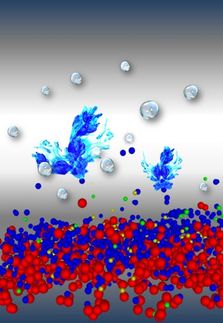Photocatalysis: Processes in charge separation recorded experimentally
The results provide clues to increase the efficiency of photocatalysts
Certain metal oxides are considered good candidates for photocatalysts to produce green hydrogen with sunlight. A Chinese team has now published exciting results on copper(I) oxide particles in Nature, to which a method developed at HZB contributed significantly. Transient surface photovoltage spectroscopy showed that positive charge carriers on surfaces are trapped by defects in the course of microseconds. The results provide clues to increase the efficiency of photocatalysts.

Contour plot of EH-Cu2O. The photovoltages are plotted as a function of photon energy (x-axis) and time (y-axis). Positive SPV signals (purple regions above 1.9 eV) correspond to the relaxation of holes trapped on {111} facets, whereas negative SPV signals (red regions) correspond to the relaxation of electrons trapped on {001} facets.
T. Dittrich / HZB
Splitting water into hydrogen and oxygen with the help of photocatalytically active particles could produce green hydrogen cheaply in the future: Sunlight activates charge carriers in photocatalysts, whose spatial separation plays a decisive role in photocatalytic water splitting. However, today's photocatalysts are still either very expensive or not very efficient.
Candidates for catalysts
Metal oxide particles are considered candidates with great potential. However, when charge carriers are activated by light, several processes overlap that take place at different speeds and on different spatial scales. To observe such processes experimentally, methods are needed that offer time resolutions down to femtoseconds, but can also observe longer processes that occur within microseconds and slower. This has now been achieved on microcrystalline copper(I) oxide particles by a team led by Fengtao Fan and Can Li from the Dalian National Laboratory for Clean Energy, China. The results are so interesting that Nature published the work and highlighted it with an News&Views article.
Fast and slow processes
Using rapid successive time-resolved photoemission electron microscopy images, the scientists showed that one of these processes occurs extremely quickly in Cu2O particles - in less than picoseconds (10-12 s): After excitation with light, electrons are transferred quasi-ballistically to {001} facets of Cu2O particles.
However, to experimentally observe a second process, a different method was required: because photogenerated "holes" migrate to {111} facets and are trapped there by defects. Thomas Dittrich was able to observe this important process using transient surface photovoltage spectroscopy (SPV spectroscopy), a method he developed at HZB. "We found that hole trapping occurred relatively slowly, over the course of microseconds," he explains.
High temporal resolution over a wide range
Taken together, the results make it possible for the first time to study and better understand processes that limit photocatalysis on microcrystalline particles with high spatial and temporal resolution over wide ranges.
Versatile method to analyse semiconductors
"With transient SPV spectroscopy, we can also investigate other semiconductors and interfaces that are relevant, for example, for applications ranging from photovoltaics and photocatalysis to high-performance electronics," says Dittrich. Interesting insights into relaxation processes can also be gained from organic semiconductors or ultra-wideband semiconductors such as diamond. "Perhaps our publication in Nature spreads the message how useful this versatile method can be," says Dittrich.
Original publication
See the theme worlds for related content
Topic World Spectroscopy
Investigation with spectroscopy gives us unique insights into the composition and structure of materials. From UV-Vis spectroscopy to infrared and Raman spectroscopy to fluorescence and atomic absorption spectroscopy, spectroscopy offers us a wide range of analytical techniques to precisely characterize substances. Immerse yourself in the fascinating world of spectroscopy!

Topic World Spectroscopy
Investigation with spectroscopy gives us unique insights into the composition and structure of materials. From UV-Vis spectroscopy to infrared and Raman spectroscopy to fluorescence and atomic absorption spectroscopy, spectroscopy offers us a wide range of analytical techniques to precisely characterize substances. Immerse yourself in the fascinating world of spectroscopy!
























































